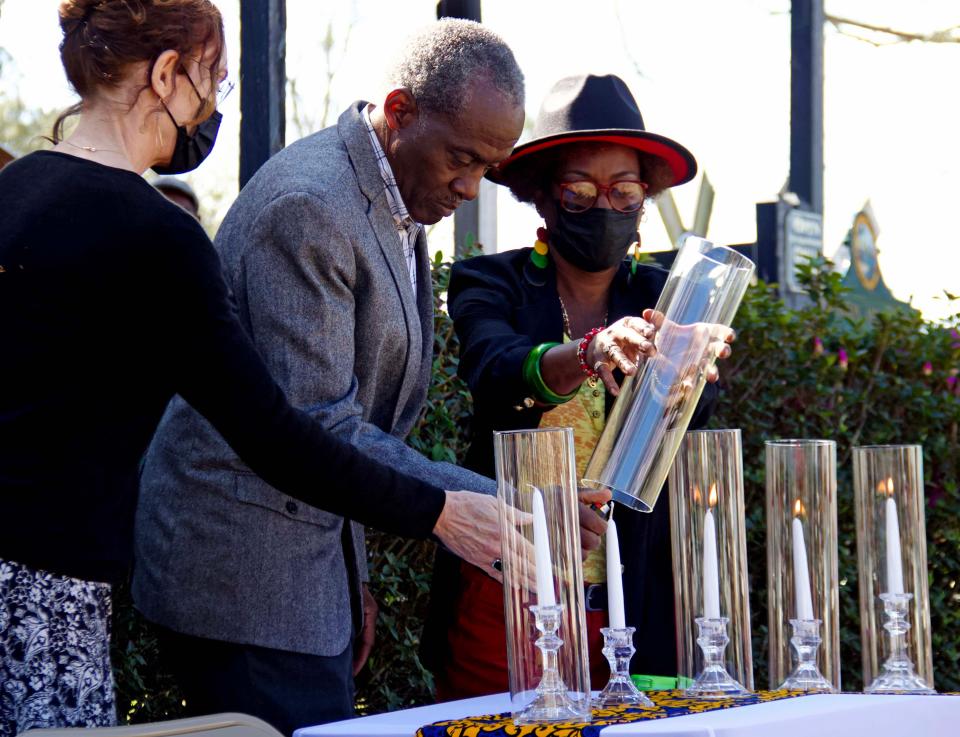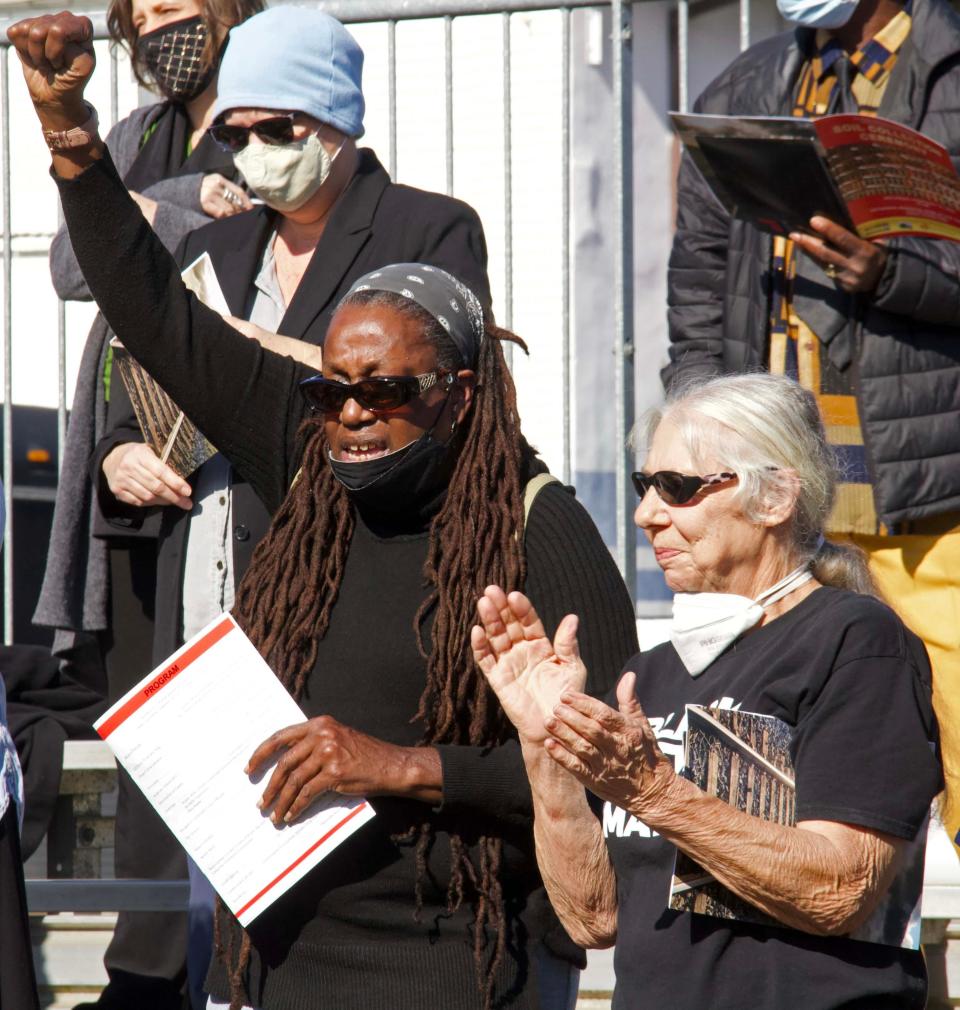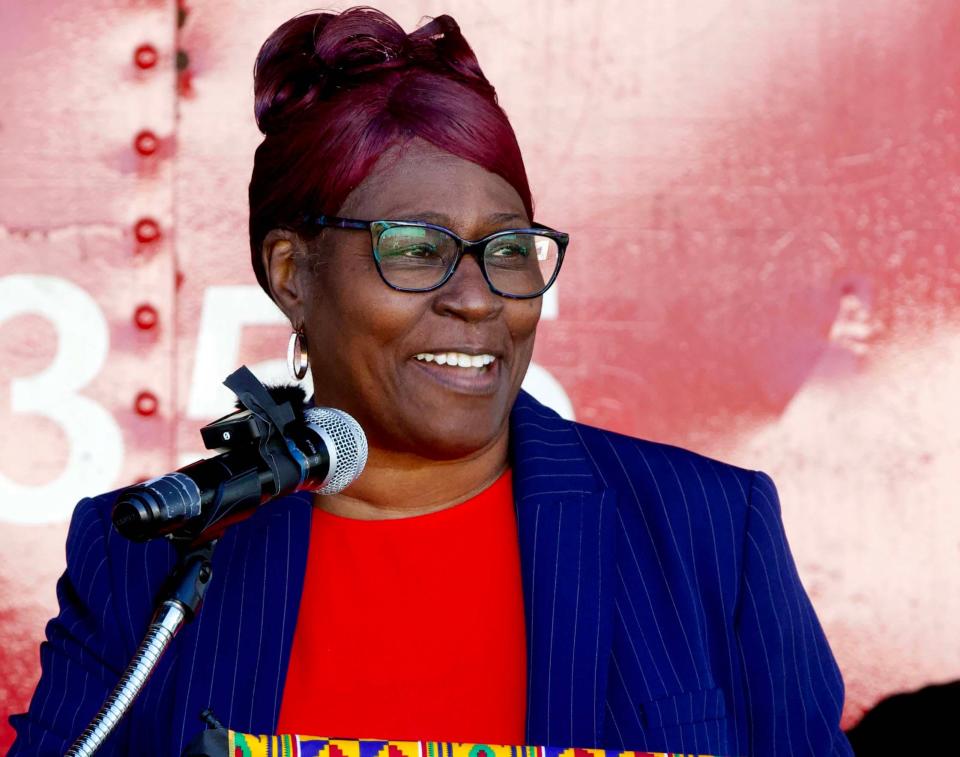Lynching victims memorialized at Waldo ceremony
An organization devoted to “truth and reconciliation” wants people to never forget that five Black people were lynched in the Waldo area about a century ago.
The Waldo-Hawthorne-Campville-Rochelle Community Remembrance Project held a ceremony on Saturday to remember those Black men who lost their lives in lynchings from 1889 to 1926.

Soil from where the lynchings occurred was toted into the event at Veterans Memorial Park at the Caboose. Attendees shoveled the dirt into two glass containers to remember each victim.
Reconciling lynchings: Reconciling lynchings in Alachua, Newnansville
Professor honored: Sculpture honoring UF professor who shined light on lynchings to stand in place of Old Joe
Historical marker: Historical marker acknowledges lynchings
One jar will remain in Alachua County while the other one goes to the Legacy Museum: From Enslavement to Mass Incarceration in Montgomery, Alabama.
The soil collection ceremony was organized by The Waldo-Hawthorne-Campville-Rochelle Community Remembrance Project, which is a subgroup of the Alachua County Community Remembrance Project.
The project, which kicked off in January 2020, is working in partnership with the Equal Justice Initiative in Montgomery, Alabama.
The initiative has partnered with community coalitions across the nation to collect soil from every lynching site to remember the victims.
About 100 people of different races braved chilly weather while attending the event in Waldo.

They prayed, lit candles as they sang “Amazing Grace," threw their arms up in the air and yelled "Amen" during pastors' sermons and listened to stories about the victims of the lynchings.
The crowd also sang inspirational songs such as “Lift Every Voice and Sing” and “How Great is Our God.”
Nii Sowa La and Naa D. Ayoka Jasey of Atlas African Methodist Episcopal Church led a drum call and libation ceremony.
Joe Lipsey, president of Waldo Concerns Citizens of the Community, said the event was not just about remembering the victims, but the importance of loving each other.
“I pray that your time spent with us today is one of acknowledgment, acknowledging that things occurred in the past in these communities that are going to be reconciled here today,” he said.
He added that “God is a God of truth, remembrance and reconciliation, but he’s also the God and the father of love.”
The stained legacy of the lynching era is felt today, said the Rev. Dr. Marie Herring, pastor of DaySpring Missionary Baptist Church.

“When we forget our history, we have a tendency to repeat our history,” she said. “The political climate in my opinion seems to be turning back to Jim Crow days.”
She said lynchings “promoted racial terror.”
“The lynchings of Negroes was terrorism, which was a widely supported campaign to enforce racial subordination and segregation,” she said.
Herring said there were more than 4,400 racial terror lynchings in the United States between Reconstruction and World War II.
“Lynchings were violent and public events that traumatized Black people throughout the country and were largely tolerated by state and federal officials,” she said.
She said the deep wounds inflicted during the "era of racial terrorism cannot be healed until we tell the truth about it.”
“The geographic, political, economic and social consequences of decades of terror lynchings can still be seen in communities today,” she said. “And the damage created by lynchings needs to be confronted and discussed, as we are doing today. Only then, can we meaningfully address the contemporary problem that are lynching’s legacy.”
The Rev. Carl Smart, a deputy county manager with Aachua County government, read the stories of the Waldo lynching victims that included:
The lynching of an unidentified Black man in Waldo on Dec. 5, 1889.
The man had been accused of stealing a valise from a passenger train at the Waldo depot.
“He was then detained at jail in Waldo,” Smart said. “During this era, African-Americans faced a presumption of guilt, and accusations of crime lodged against Black people were rarely thoroughly investigated.”
The white men broke into the jail and beat the man, and then shot him to death when he attempted to defend himself.
No one was ever held accountable for the lynching, Smart said.
The lynching of an unidentified Black child in Waldo on Sept. 6, 1892.
On that night, a mob lynched an unidentified Black boy who had been accused of burglary and arson, “though there had been no investigation, and newspaper reports did not suggest any evidence tying him to the offense.”
The mob hanged him from the beam of a storage building, and his lynched body was left hanging for at least one day.
The lynching of Charles Wiley in Rochelle on Jan. 12, 1894.
Newspapers reported that Wiley was shot and seriously wounded by a white man that night. He went to a nearby house and laid in bed suffering from his injuries. A group of white men tracked him down and riddled his body with buckshot. “They then set the bed on fire with Mr. Wiley in it,” Smart said. “Newspaper articles suggested that prior to the lynching, Mr. Wiley had used ‘strong language’ towards a white man in his yard, which led to an altercation in which Mr. Wiley was hit just below the breastbone, with the bullet lodging in his hip."
Again, no one was ever held accountable for the lynching, Smart said.
The lynching of Henry White in Campville.
On that day, a white mob abducted a young Black man named Henry White from the waiting room of a train station, where he was being held captive by a group of young white men, and hung him to death on a nearby tree. News reports say young white men from Hawthorne went calling on an unidentified white woman in Campville, and Henry was allegedly discovered hiding under the bed.
“During this era, one of the racial boundaries white men protected most fiercely was the prohibition on sexual, romantic or intimate contact between Black men and white woman," Smart said.
This article originally appeared on The Gainesville Sun: The Waldo-Hawthorne-Campville- Rochelle Community Remembrance Project held a ceremony on Saturday to remember Black men who lost their lives

